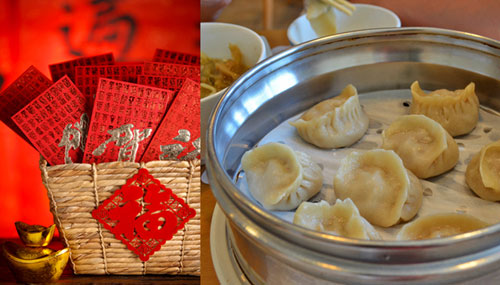East West Lifestyle
Recipes of Asia: Dumplings for Chinese New Year
By Clarissa Wei

Food blogger Clarissa Wei on the luckiest foods to make and eat for Chinese New Year.
A year ago, I spent my first Chinese New Year in China. Promptly afterwards, I vowed never to do such a thing again.
Also known as the “spring migration,” the Chinese New Year season is cause of the world's largest annual human migration. Millions of families scrambling to get home to the countryside from the cities means an influx of traffic on the roads and a packed public transportation system. It’s virtually impossible to snag a last-minute ticket anywhere, so good luck in traveling the country while upwards of 1.3 billion people are doing the same.
I was lucky enough to snag a personal invite to a friend’s family dinner in Nanxun, a small watertown in the Zhejiang Province of China. We feasted on a dinner of auspicious foods: whole fish, spring rolls, dumplings, eggs, shrimp, etc. It was a spread of more than 18 dishes for just a party of five. It was spectacular sight, chock full of symbolism.
The Chinese are a superstitious bunch, and we believe that eating foods that symbolize happiness, auspiciousness, health and wealth will bring just those things in the upcoming year. And, though not every family strictly adheres to this principle, you’ll find at least a whole fish (which symbolizes unity) and rice cakes (which means increasing prosperity year after year) on every table.

Here’s a breakdown of the symbols:
Whole fish: the word fish in Chinese, yu, invokes the phrase “may the new year bring prosperity” (nian nian you yu). A whole fish is a must, as it symbolizes unity within the family.
Rice cakes: rice cakes, nian gao, come in both sweet and savory forms. The savory versions are more common; they’re usually shaped into thin disks and then stir-fried. The sweet ones, baked and stuffed usually with red bean, start appearing in local Chinese supermarkets exclusively around the holiday time. The word nian gao correlates to the phrase “increasing prosperity year after year (nian nian gao sheng).
Shrimp: the crustacean is pronounced xia in Mandarian and ha in Cantonese. The words sound like laughter, so shrimp is consumed during the Lunar New Year in hopes of annual happiness.
Sweet rice balls: these are usually eaten during the last day of the celebration, when the full moon comes out. They are traditionally stuffed with sesame paste, ground peanuts or red bean. The roundness of the rice ball is supposed to be indicative of a complete circle of harmony within the family.
Noodles: noodles are a symbol of longevity—the longer the better. They’re usually served uncut.
Mustard Greens: mustard greens, or jie cai, are a standard vegetable dish for the celebration. They’re also known as chang nian cai, which translates to "perennial vegetables." It’s symbolic for longevity; the associated phrase is chang chang jiu jiu, which means "long life."
While I am not in China for the festivities this year, there is definitely not a shortage of Chinese restaurants here in Los Angeles to celebrate at. My family is out of town, so I will be passing the festivities with a plate of dumplings. It sounds simple, but the shape of dumplings is reminiscent of gold ingots, which was the currency in China back in the day. The thought is that the more dumplings you consume, the more wealth you will accumulate. Also, the associated saying is gen shui jiao zhi, which means “ring out the old year and ring in the new.” Jiao zhi is the Chinese word for dumplings.

"It’s great as a healthy start to the New Year."
Ker Zhu, the owner of Luscious Dumplings over in Monrovia, Calif., was kind enough to supply his recipe for steamed vegetarian dumplings. It’s a surprisingly simple filling mix, with no more than a dozen ingredients. The meat of the dish is the shiitake mushrooms, and the vegetarian oyster sauce gives it a hearty finish. Zhu recommends pairing the dumplings with a vinegar-only dipping sauce.
“It’s great as a healthy start to the New Year,” he says.

Chinese Steamed Vegetarian Dumplings
Cooking time: 1 hour
Servings: 4 people
Ingredients:3-4 packages of dumpling wrappers
For the filling:
- 1 pound shiitake mushrooms, soaked overnight and re-hydrated, diced finely
- 1/2 pound carrots, diced finely
- 1/2 pound Napa cabbage, diced finely
- 1/2 pound firm bean curd, diced finely
- 1/4 pound shallots
- 1/2 pound glass noodles, soaked overnight and re-hydrated, diced finely
Seasoning:
- Canola oil
- Salt, to taste
- White pepper, to taste
- Dash white sugar
- 2 tbsp Vegetarian oyster sauce
- Heat up the canola oil in a large pan. Throw in the shallots and sauté briefly.
- Add in the mushrooms. Stir-fry until you can smell the aromatics coming through.
- Put in the cabbage, carrots, bean curd, and stir-fry for a bit. Add a couple dashes of white pepper, sugar and salt.
- Then add in the bean curd and the vegetarian oyster sauce.
- The last thing you put in is glass noodles.
- Turn off the heat and let it cool. Transfer to bowl. This will be the filling for the dumplings.
- Wrap the filling in the wrappers.
- Steam for five minutes.
Subscribe to the Reach Further Newsletter
Get inspiring stories in your inbox every month.

